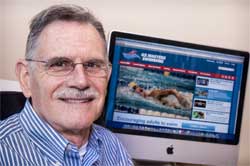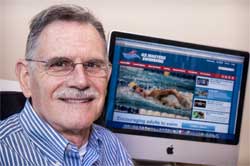 KINGSTON, RI – May 22, 2013 – The fountain of youth is really a pool of chlorine. Just ask Tom Manfredi, a 70-year-old professor of kinesiology at the University of Rhode Island who looks 20 years younger thanks to decades of swimming.
KINGSTON, RI – May 22, 2013 – The fountain of youth is really a pool of chlorine. Just ask Tom Manfredi, a 70-year-old professor of kinesiology at the University of Rhode Island who looks 20 years younger thanks to decades of swimming.
His passion – no, obsession – helped him reach a personal best this year when he earned a major honor at the New England Masters Championship meet in March at Harvard University. He swam 13 individual events in his 70 to 75 age group during the three-day competition and scored second highest in total points among 450 male swimmers, ranging in age from 17 to 85.
“I’m happy,” says Manfredi. “I’m very lucky I’ve got my health.”
Luck might play a small role in his success, but it’s really those long hours in the pool that have turned him into a gracefully aged version of Olympian Michael Phelps, who, like Manfredi, is a butterfly swimmer.
To all you couch potatoes, consider this: Manfredi swims nearly every day, and when he’s training for a competition he swims even more. To prepare for the Masters meet, he swam 12 hours a week and lifted weights four hours a week.
All that hard work has paid off: He weighs 160 pounds, only three pounds more than he weighed in college. His total cholesterol is 135, way below the average of 200 for American men and women. (Lest there’s any doubt, check his medical files; he has the results of every blood chemistry test for the past 35 years.) Needless to say, Manfredi does not have high blood pressure or any other disease that afflicts people in their golden years.
Fitness is part of Manfredi’s professional life too. He studies how exercise – especially swimming – makes the heart stronger. He has found that swimming enlarges the heart in a healthy way, reducing the risk of heart disease, high blood pressure, and heart failure.
For the past several years, Manfredi and other professors and students at URI have been studying the hearts of rats that swim and comparing the findings to rats with diseased hearts. Pharmaceutical companies are paying close attention to the results.
“For me, this is wonderful because I’m nearing the end of my career and this is the most exciting study I’ve done,” he says. “It’s been very satisfying to use my interest in swimming and apply it to my academic research.”
Manfredi learned how to swim in the pool at Park View Middle School in Cranston, where he grew up. He and his twin brother, Jim, were naturals and started competing when they were 12. Jim’s stroke was freestyle; Tom preferred butterfly. “I just liked being in the water,” says Manfredi. “It felt good.”
At Cranston High School, now Cranston East, the boys swam for legendary coach Ed Golden, a tough-love guy who used a bullhorn at swim practices and took attendance with a clipboard. At one point, Manfredi was among the top six male butterfly swimmers in the country. His team was so good it had a 125-0 record over four years.
“In three years I missed half a practice and I heard about it for a long time from the coach,” says Manfredi. “We used to swim seven days a week. We had Christmas off.”
His talent led to a full scholarship at the University of Maryland, where he helped the Terrapins win the Atlantic Coast Conference championship two years in a row. The first in his family to go to college, Manfredi received a bachelor’s in physical education and got his doctorate in exercise science from the University of Massachusetts, Amherst. He started teaching at URI in 1982.
Swimming is the perfect all-around sport. It increases your heart rate, but without putting a lot of stress on bones and joints. Think about those sore knees after a long run.
The activity builds up endurance and strengthens the heart. It also tones muscles from head to toe. (Just peek into Manfredi’s office for a look at a man with no body fat.) Finally, it’s a great way to be alone in this hectic world.
“It’s you and the water,” says Manfredi, who swims at a pool on campus. “It’s euphoric and cathartic at the same time. You can swim hard or you can just go in there and relax.”
Back in 1982, Manfredi took two years off from swimming because he was too busy at work. He’d put on his Speedo in the locker room, walk to the exit door, and stop. Then he wised up. Swimming, he decided, should be “at the top of my priority list.”
He started competing in Masters swimming in 1976 and now competes for Swim Rhode Island, one of the 81 clubs in the New England Masters organization. Masters is a fast-growing class of competitive swimming for men and women 17 and older. They compete in age groups, at five-year intervals. There are individual races, as well as relays. Requirements to join vary from club to club. Some swimmers are beginners; others, like Manfredi, are advanced.
In the March competition, Manfredi swam in 17 events, including 13 individual events. Of those 13, he placed first in 11 events and second in two events. He also broke two new records in his age group.
The wins are great, but he also enjoys seeing his swimming pals from bygone years at the meets. “I’m swimming with people I swam against in high school,” he says, with a chuckle. “It’s great.”
The secret to good health, he says, is exercise, a high-fiber diet with plenty of fruits and vegetables, and a positive outlook. “You’ve got to take control of your own body,” he says. “No one’s going to do it for you. Don’t look at that as a responsibility. Look at your body as a gift.”
Like all great competitors, Manfredi is already thinking about his next competition. Next year, he hopes to be the top scorer among men at the New England Masters meet. He might also try swimming this summer in the salty Atlantic, where his biggest worry is confronting a shark. The only thing you have to worry about in a pool is making a lousy flip turn.
Pictured above: Tom Manfredi, a 70-year-old professor of kinesiology at the University of Rhode Island who earned a major honor at a recent New England Masters swim meet. He was inducted into the Rhode Island Aquatic Hall of Fame in 1991.
Photo by Michael Salerno Photography.

